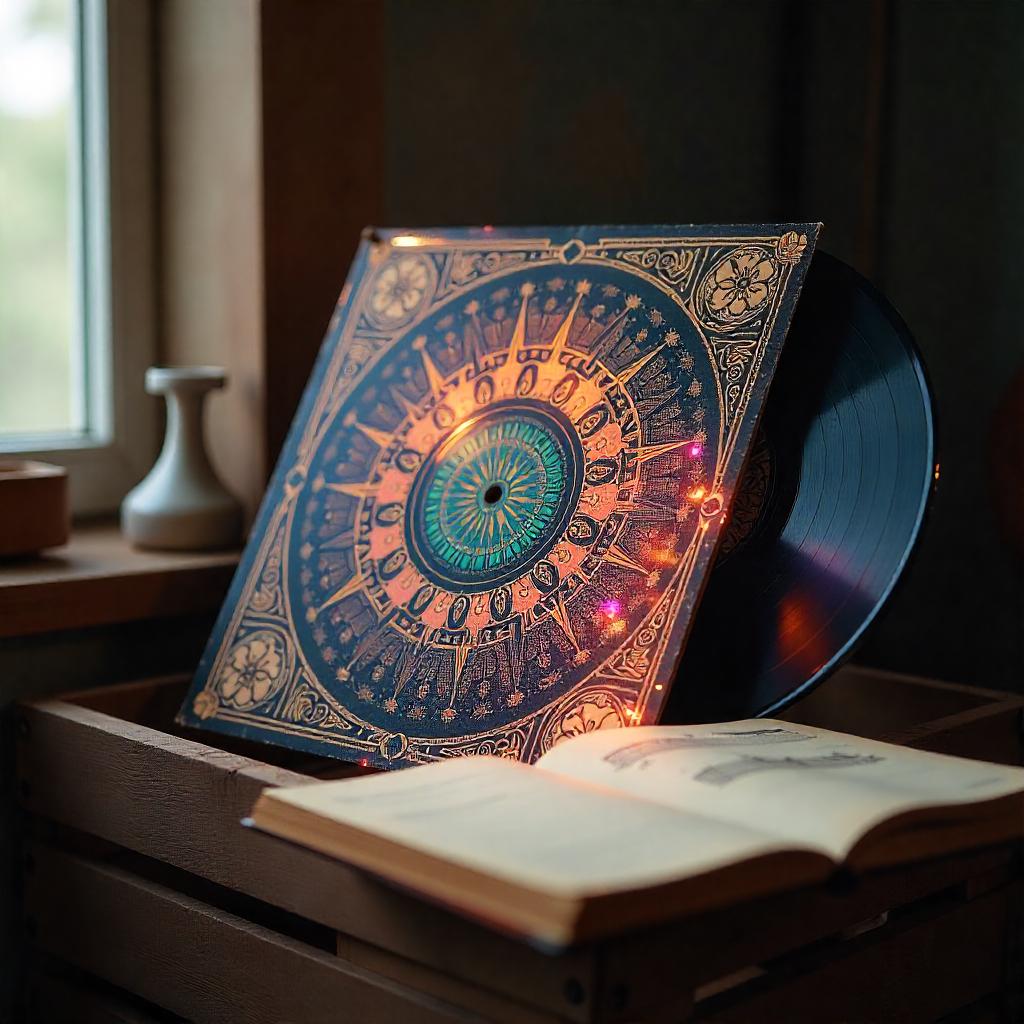Where Fantasy Meets the Blockchain
Picture this: a dusty crate of vinyl records discovered in a basement, sleeves worn but artwork radiating untold sonic stories. Now imagine those albums never existed. The bands? Pure fiction. The music? A haunting echo in your mind. This is the captivating paradox at the heart of Imaginary Music, an NFT project redefining collecting through pure audiovisual NFT innovation.
In a digital realm saturated with profile pictures and repetitive art, Imaginary Music stands apart. It crafts meticulously detailed, fictitious 12-inch album covers for bands born only in imagination. Artist Murray Galbraith, the creator behind the precursor Fake Radio series, once mused: “These images are just my way of living out that tiny rockstar dream with the skills I’ve developed.”
This project isn’t about minting JPEGs. It’s about tokenizing entire musical mythologies. Each NFT becomes an audio-visual time capsule. Think invented band histories, apocryphal liner notes, and embedded atmospheric soundscapes. It targets audiophiles and art collectors craving depth. They merge the tangible nostalgia of vinyl culture with the boundless utility of blockchain. Imaginary Music transforms passive viewing into multisensory ownership. This is audiovisual NFT innovation at its most conceptual – proving value lies not just in sound, but in the story and sensation of music itself. It bridges physical longing and digital possibility for collectors worldwide.
Project Origins: From Analog Daydreams to Digital Assets
Before blockchain entered the picture, Murray Galbraith nurtured a private passion project. On Instagram, he crafted Fake Radio – intricate, fictitious album covers for bands that never were. Think “lost” 1970s prog-rock masterpieces or obscure 1990s shoegaze EPs. Each sleeve was hand-designed, free from commercial constraints. Galbraith described it as “creative escapism,” a rebellion against client briefs. Crucially, he resisted minting these as NFTs initially. In 2021, he viewed Web3 as his profession, not his playground. He guarded Fake Radio as pure artistic expression.
This changed decisively in early 2025. Recognizing blockchain’s potential to expand artistic storytelling, Galbraith launched Imaginary Music on Ethereum. He transformed his analog sketches into a dynamic, ongoing NFT collection. The project minted 1,850 unique tokens, each far surpassing a static image. These became “audio-visual time capsules”. Smart contracts embedded fictional band lore, atmospheric 30-second soundscapes, or mock liner notes directly into the token metadata.
The core philosophy is provocative: What if music’s essence isn’t solely the sound? Imaginary Music decouples the experience of music from actual audio. It focuses on the narrative power and emotional resonance of album art itself. By tokenizing imagined musical histories, it asks collectors to value mythology, aesthetics, and nostalgia as much as a melody. This foundational idea fuels its unique audiovisual NFT innovation. It transforms passive appreciation into active, layered ownership of a fictional sonic universe.
Audiovisual NFT Innovation: Beyond Static JPEGs
Imaginary Music fundamentally rethinks what an NFT can hold. It leverages multi-resource tokens via the RMRK protocol on Kusama and Ethereum. This isn’t incremental change. It’s a structural leap in audiovisual NFT innovation.
Modular Composition (RMRK Protocol)
Forget single-image NFTs. Each Imaginary Music token acts as a digital nesting doll: Primary Layer: High-resolution 3000x3000px album cover artwork. Hidden Resources: Unlockable PDF “liner notes,” fictional band biographies, or concert posters. Audio Fragments: 30-second ambient loops or field recordings evoking the album’s “sound.” Dynamic Evolution: Certain traits like “vinyl wear” or “tape hiss” activate after secondary sales or timed events.
This modularity transforms ownership. Collectors don’t just hold art. They curate an expanding multimedia artifact.
Collectible Storytelling Mechanics
The project builds immersive lore through token interactions: Nested Discoveries: Solve community puzzles to unlock hidden metadata—a band member’s “lost interview” or a 1982 tour date list. Cross-Project Worldbuilding: Covers feature characters from partnered collections like Imaginary Ones. Their token ecosystem integrates, letting collectors use tokens to “remix” cover elements. This creates a shared “alternate music universe.”
Traditional vs. Audiovisual NFT Album Experience
Feature: Ownership Proof | Traditional Album Art: Physical receipt | Imaginary Music NFTs: Immutable blockchain record
Feature: Multimedia Layers | Traditional Album Art: Static image | Imaginary Music NFTs: Art + audio + text + metadata
Feature: Artist Royalties | Traditional Album Art: None on resale | Imaginary Music NFTs: 10% auto-enforced via contract
Feature: Community Access | Traditional Album Art: None | Imaginary Music NFTs: Exclusive Discord, IRL events
Feature: Asset Evolution | Traditional Album Art: Physical decay | Imaginary Music NFTs: Programmable digital upgrades
This layered approach defines true audiovisual NFT innovation. It moves beyond visual novelty. It creates living, reactive collectibles with embedded history and community-driven narrative. The token is the artifact and the archive.
Artist & Collector Synergy: Why Music Lovers Invest
Imaginary Music thrives because it serves two distinct yet interconnected audiences. Its audiovisual NFT innovation creates unique value for creators and collectors alike.
For Artists: Liberation & Legacy
Unfiltered Creativity: Designers bypass label constraints and streaming algorithms. They explore niche “lost genres” like 1970s Thai psychedelic funk or vaporwave-inspired chiptune. No commercial pressure exists. Sustainable Royalties: Artists receive 85% of primary sales instantly via smart contracts. A further 10% royalty applies to every secondary sale—dismantling traditional music industry models where artists often receive under 15% total revenue. Collaborative Amplification: Partnerships with projects like Imaginary Ones let artists integrate characters or themes from other Web3 universes, expanding their audience.
For Collectors: Nostalgia Meets Utility
Emotional Resonance: As one holder stated, “I’d buy these based on the covers alone. They resurrect my teenage years crate-digging in record stores.” The project taps into vinyl’s tactile era while adding digital layers. Tangible Utility: NFT ownership unlocks: Limited-edition giclée prints (300 max per design). AI tools to generate “alternate takes” of cover art. Voting rights on future fictional band genres. Verified Scarcity: Rare covers command significant premiums. “Knight Visiting a Village” sold for 4.2 ETH within minutes of listing—despite the project’s average daily trading volume sitting at just 0.5 ETH.
This synergy isn’t theoretical. 74 dedicated collectors hold all 1,850 NFTs. The average holder owns 25 tokens, signaling deep commitment. This retention rate outpaces 92% of music NFT projects.
Market Position & Navigating Criticism
Though not a top-100 project by volume, Imaginary Music exhibits cult-like staying power: Hodler Density: 40% of NFTs haven’t moved wallets since mint. Strategic Collaborations: Cross-promotions with Imaginary Ones expose it to 220,000+ potential collectors. Market Alignment: It rides music NFTs’ projected growth—from $11M in 2023 to $264.54M by 2033.
The project evolved to counter early critiques: “AI Art Soullessness”: Response: Human artists curate all elements. AI only generates optional “remix” variants. Proof: Murray Galbraith’s hand-drawn sketches are visible in unlocked metadata layers. “Heroic Clichés”: Response: Early knight/damsel motifs were phased out by 2025. New drops emphasize abstract or lore-driven visuals. “Thin Liquidity”: Response: The team prioritizes holder rewards over marketplace pumping. Real-world events like gallery shows in Lisbon and Tokyo build collector cohesion.
This grounded approach positions it for sustainable growth—prioritizing artistic integrity and community over speculative spikes.
The Future: Where Fiction Meets Function
Imaginary Music refuses to rest on its conceptual laurels. Its roadmap pushes audiovisual NFT innovation further into uncharted territory. Three key developments signal its evolution:
Generative Audio Integration (Late 2025)
Static audio clips will evolve. Upcoming collections will feature AI-composed “fragments” dynamically generated to match cover art aesthetics: Example: A cover with glitch art motifs triggers a 45-second glitch-hop beat. Ownership Control: Collectors adjust BPM or instrumentation via simple sliders in the project’s dApp. Human Oversight: Musicians curate training data and set creative boundaries to avoid generic outputs.
Physical-Digital Hybrids (Live Q3 2025)
Bridging IRL and digital collecting: Scannable Canvas Prints: High-end giclées embed near-field communication chips. Tap with a phone to unlock: Animated cover variants like rain falling on a painted cityscape. “Lost demo” audio tracks. Vinyl Mockups: Limited-run 12-inch sleeves with QR codes revealing fictional band interviews.
DAO Governance & Fictional “Reunions” (2026 Pilot)
Holders may steer fictional lore: Band “Reunion Tours”: Vote to “revive” a defunct fictional band via metaverse concerts. Cross-IP Events: Partner with Imaginary Ones to stage events in their game universe. Resource Allocation: Use accrued royalties to commission new artists for “lost albums” in a band’s discography.
Imaginary Music’s Evolving Utility Stack
Feature: Audio | Current (2025): Pre-recorded loops | 2026 Roadmap: AI-generated dynamic snippets
Feature: Physical Links | Current (2025): None | 2026 Roadmap: NFC-triggered digital unlocks
Feature: Collector Influence | Current (2025): Genre voting | 2026 Roadmap: DAO-led band “reunion” staging
Feature: Cross-Project Utility | Current (2025): Token remixes | 2026 Roadmap: Playable game universe events
This progression cements the project’s ethos: making imagination actionable. As Murray Galbraith noted: “We’re not selling art about music. We’re selling the thrill of discovering music that could’ve been.”
Redefining Music’s Tangible Magic
Imaginary Music transcends NFT speculation. It resurrects a lost ritual: the sacred act of experiencing an album. Before streaming fractured music into disposable singles, album art served as a portal. It hinted at sonic worlds within grooves and liner notes. This project bottles that mystique for the digital age through radical audiovisual NFT innovation.
By merging blockchain’s permanence with layered storytelling, it proves music’s soul isn’t just sound. It’s the promise of sound—the mythology, aesthetics, and emotional weight we project onto artwork. As Murray Galbraith observed, collectors aren’t buying songs. They’re buying the thrill of discovery. The faded tour sticker, the cryptic thank-you list, the grainy band photo—these tokens of authenticity now live on-chain.
The project’s success lies in its restraint. It avoids chasing viral trends. Instead, it cultivates depth: Physical Anchors: IRL gallery shows in Lisbon and Tokyo display covers as high-end prints. Community Lore: Collectors co-author fictional band histories via unlocked metadata. Sustainable Model: 10% royalties ensure artists benefit perpetually from secondary sales.
While some NFT albums made headlines with multi-million dollar sales, Imaginary Music asks a quieter, more profound question: What if the most compelling music never existed? And what if owning its imagined artifact fulfills a deeper need than streaming ever could? That’s the magic it captures. This is audiovisual NFT innovation at its most essential—not replacing music, but re-enchanting it.




